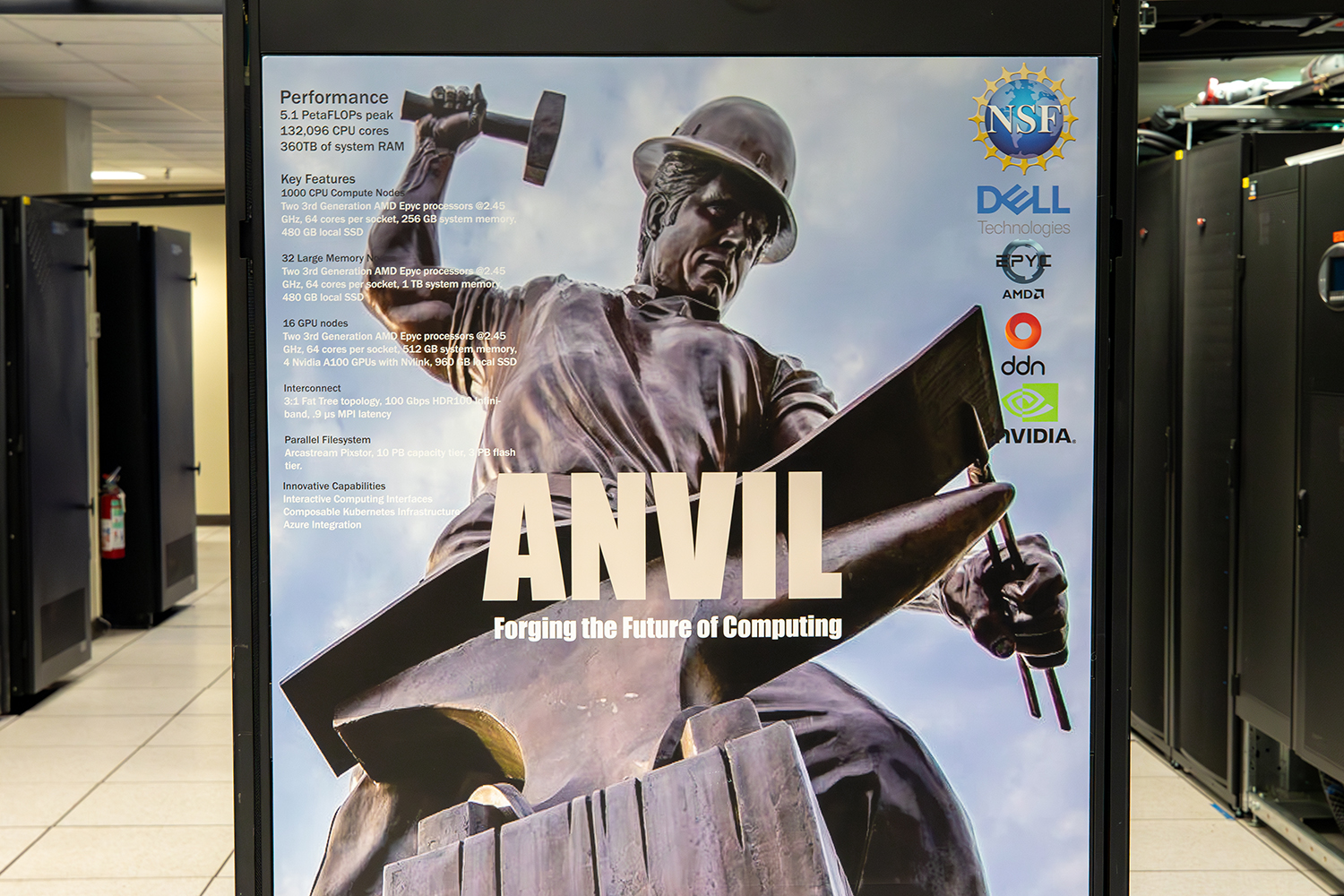Purdue University receives $4.9 million NSF award to enhance Anvil to support AI research
The National Science Foundation (NSF) has recently awarded a $4.9 million supplement for Anvil, Purdue University’s most powerful supercomputer. This funding has been given in part to support the newly launched National Artificial Intelligence Research Resource (NAIRR) Pilot. This NSF supplement will enable Purdue to further expand Anvil’s graphics processing unit (GPU) compute capabilities to support AI, support high-performance object storage, and provide the operational support needed for users of the NAIRR Pilot.
Initially funded by a $10  million acquisition grant from the NSF, Anvil began early user operations in November 2021 and entered production operations in February 2022. Its purpose is to supply researchers from diverse backgrounds with advanced computing capabilities while providing a low barrier of entry for new-to-HPC users. Over the past two years, Anvil has had a significant impact on scientific research and student development. With nearly 6,000 total users thus far, of which over 3,000 were undergraduate students, Anvil is not only helping meet the growing need for HPC within the realms of research, but also actively assisting with the development of cyberinfrastructure professionals of tomorrow. So far, the supercomputer has helped push the boundaries of scientific exploration in 62 different fields, including artificial intelligence, mechanical and materials engineering, astrophysics, climatology, and nanotechnology. This new NSF supplement will allow Anvil to continue to enable discovery with increased capacity to support research in artificial intelligence through the addition of the latest Nvidia H100 GPUs.
million acquisition grant from the NSF, Anvil began early user operations in November 2021 and entered production operations in February 2022. Its purpose is to supply researchers from diverse backgrounds with advanced computing capabilities while providing a low barrier of entry for new-to-HPC users. Over the past two years, Anvil has had a significant impact on scientific research and student development. With nearly 6,000 total users thus far, of which over 3,000 were undergraduate students, Anvil is not only helping meet the growing need for HPC within the realms of research, but also actively assisting with the development of cyberinfrastructure professionals of tomorrow. So far, the supercomputer has helped push the boundaries of scientific exploration in 62 different fields, including artificial intelligence, mechanical and materials engineering, astrophysics, climatology, and nanotechnology. This new NSF supplement will allow Anvil to continue to enable discovery with increased capacity to support research in artificial intelligence through the addition of the latest Nvidia H100 GPUs.
Anvil’s system currently consists of 1,000 Dell compute nodes, each with two 64-core third-generation AMD EPYC processors, 32 large memory nodes with 1 TB of RAM per node, and 16 GPU nodes, each with four NVIDIA A100 Tensor Core GPUs, all of which are interconnected with 100 Gbps Nvidia Quantum HDR Infiniband. The new NSF funding will add 21 Dell PowerEdge XE9640 compute nodes, each with 4 Nvidia 80GB H100 SXM GPUs, as well as an additional 1 PB of flash-based object storage to be integrated into Anvil’s composable subsystem. The new GPU nodes will also feature an additional NDR Infiniband fabric to support larger AI workloads.
“Anvil joined the NAIRR Pilot as a resource provider in May this year,” says Rosen Center Chief Scientist Carol Song, principal investigator and project director for Anvil. “We made available Anvil’s discretionary capacity, which was allocated entirely to researchers, right away. This H100 GPU expansion will not only give Anvil a significant boost to the amount of resources available to the NAIRR Pilot users, but will also provide a major increase in Anvil’s GPU computing power. The H100 GPU outperforms the current A100 GPU in Anvil by as much as nine times in computing speed. Many workloads, especially AI model training and inference, will run much faster, reducing the time-to-results for researchers.”
The new H100 GPUs will provide Anvil with enhanced performance capabilities, enabling advancements in artificial intelligence research in a variety of fields, such as:
- Resilient federated learning
- Securing Large language models (LLMs) against adversarial attacks
- Advancing AI research and methods in traditional science and engineering domains
The new nodes will also allow Anvil to further enhance its world-class outreach and training capabilities and initiatives, as well as enable dedicated AI expert support for AI researchers. As an official resource provider for the NAIRR Pilot, Anvil will directly support the advancement of NAIRR’s primary goals, namely: spurring innovation, increasing diversity of talent, improving capacity, and advancing safe, secure, and trustworthy AI in research and society.
“We are very excited to take part in such an important effort and help provide the nation with advanced AI computing resources,” says Song. “Anvil was intended to lower barriers to applications of high-performance computing, with AI being a key workload. Joining the NAIRR, the Anvil team will bring together Purdue’s long history of supporting advanced computing with the experts being assembled on our campus to work on strategic initiatives, including Purdue Computes and the new Institute for Physical AI.”
Researchers interested in using Anvil as part of the NAIRR pilot can apply for an allocation via the NAIRR pilot resource request. More information about Anvil is available on Purdue’s Anvil website. Anyone with questions should contact anvil@purdue.edu. Anvil is funded under NSF award No. 2005632.
Written by: Jonathan Poole, poole43@purdue.edu
